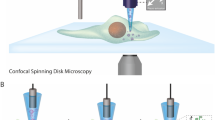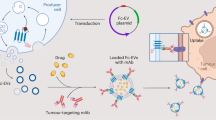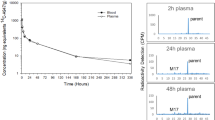Abstract
A new in vitro model has been developed for investigating extravascular diffusion of therapeutic agents in tumour tissue. V79-171b or EMT6/Ak cells are grown on porous Teflon support membranes and submerged in a large reservoir of medium, to give diffusion-limited 'multicellular membranes' (MMs) c. 200 microm in thickness. MMs are histologically similar to multicellular spheroids, but their planar rather than spherical geometry facilitates direct measurement of the flux of radiolabelled agents through the multicellular structure. For [14C]urea, flux kinetics through V79-171b MMs was modelled as simple diffusion, yielding a diffusion coefficient in the MM (DMM) of 1.45 x 10(-6) cm2 s(-1), 11-fold lower than in culture medium. Flux of the 3H-labelled DNA intercalator 9-[3-(N,N-dimethylamino)propylamino]acridine (DAPA) was dramatically slower than urea. Modelling this over the first 5 h gave a DMM of 1.3 x 10(-8) cm2 s(-1), but over longer times the kinetics was not consistent with simple diffusion. Flux of DAPA was markedly increased in the presence of 50 mM ammonium chloride, indicating that sequestration in acidic endosomes is a major impediment to flux. Accumulation in cytoplasmic vesicles was confirmed by fluorescence microscopy. The DAPA flux kinetics, with and without ammonium chloride, was well fitted by a reaction-diffusion model with reversible cellular uptake (modelled as binding), using uptake parameters determined in separate experiments with V79-171b single-cell suspensions. This study demonstrates the utility of the MM model for determining extravascular transport parameters, and indicates that much of the impediment to diffusion of basic DNA intercalators in tumour tissue may arise from lysosomal sequestration rather than DNA binding.
This is a preview of subscription content, access via your institution
Access options
Subscribe to this journal
Receive 24 print issues and online access
$259.00 per year
only $10.79 per issue
Buy this article
- Purchase on Springer Link
- Instant access to full article PDF
Prices may be subject to local taxes which are calculated during checkout
Similar content being viewed by others
Author information
Authors and Affiliations
Rights and permissions
About this article
Cite this article
Hicks, K., Ohms, S., van Zijl, P. et al. An experimental and mathematical model for the extravascular transport of a DNA intercalator in tumours. Br J Cancer 76, 894–903 (1997). https://doi.org/10.1038/bjc.1997.481
Issue Date:
DOI: https://doi.org/10.1038/bjc.1997.481
This article is cited by
-
Elucidating the Uptake and Distribution of Nanoparticles in Solid Tumors via a Multilayered Cell Culture Model
Nano-Micro Letters (2015)
-
Penetration of anticancer drugs through tumour tissue as a function of cellular packing density and interstitial fluid pressure and its modification by bortezomib
BMC Cancer (2012)
-
Transport kinetics of four- and six-coordinate platinum compounds in the multicell layer tumour model
British Journal of Cancer (2007)
-
The nitroreductase prodrug SN 28343 enhances the potency of systemically administered armed oncolytic adenovirus ONYX-411NTR
Cancer Gene Therapy (2007)
-
Inhibition of endosomal sequestration of basic anticancer drugs: influence on cytotoxicity and tissue penetration
British Journal of Cancer (2006)



